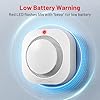Most people think of duct detectors as being used only in commercial buildings, but they have many applications. The primary purpose of a duct detector is to provide an early warning of a fire in a duct system. They are also used to monitor the air quality in a duct system and to provide data for building code compliance.
Contents
The primary purpose of a duct detector is to detect the presence of smoke and heat in a duct system.
The primary purpose of a duct detector is to detect the presence of smoke and heat in a duct system. When smoke or heat is detected, the duct detector will send a signal to the fire alarm system, which will then sound the alarm and notify the fire department.
Duct detectors play an important role in fire safety and protecting building occupants.
Duct detectors are devices that are installed in HVAC systems to monitor for the presence of fire and smoke. They are an important part of fire safety because they can provide an early warning of a fire, which can help to protect building occupants.
Duct detectors are typically installed in the ductwork of a building, and they work by detecting the presence of smoke or heat. When a duct detector is triggered, it will send a signal to the fire alarm system, which will then activate the fire sprinklers.
Duct detectors are required by code in many jurisdictions for new construction and renovations.
The primary purpose of a duct detector is to provide an early warning of a fire in the ductwork of a building. By code, duct detectors are required in many jurisdictions for new construction and renovations. Duct detectors are usually installed in the ceiling space above the ceiling tiles.
When a fire is detected in the ductwork, the detector sends a signal to the fire alarm system, which then triggers the building’s fire alarm.
Duct detectors are available in a variety of styles and configurations to meet the needs of different applications.
Duct detectors are designed to detect the presence of smoke, heat, or fire within an air duct system. They are typically installed in commercial and industrial buildings where the ductwork forms part of the HVAC system. The primary purpose of a duct detector is to provide an early warning of a fire within the ductwork, so that the building can be evacuated and the fire extinguished before it spreads.
Duct detectors are available in a variety of styles and configurations to meet the needs of different applications. The most common type is the air-sampling duct detector, which consists of a sensing head that is installed within the ductwork and a control unit that is located outside the ductwork.
The sensing head contains one or more sensors that monitor the air flowing through the ductwork for the presence of smoke, heat, or fire. When the sensors detect the presence of smoke, heat, or fire, they send a signal to the control unit, which activates an alarm.
Other types of duct detectors include those that use optical, ultraviolet, or infrared sensors to detect the presence of smoke, heat, or fire. These detectors are typically more expensive than air-sampling duct detectors, but they offer the advantage of being able to detect a fire in its early stages, before it has had a chance to spread.
Duct detectors must be properly installed and maintained to ensure they are effective.
The primary purpose of a duct detector is to detect the presence of smoke or other combustion products in air moving through HVAC ducts. Duct detectors are an important part of comprehensive fire detection and alarm system. They are typically installed in the supply and return air ducts of HVAC systems. Duct detectors are usually wired to the fire alarm control panel (FACP) and activate the alarm when smoke is detected.
False alarms from duct detectors are a common problem that can be addressed with proper design and maintenance.
Duct detectors are designed to detect the presence of smoke within a duct system and activate the building’s fire alarm system. However, false alarms from duct detectors are a common problem that can be addressed with proper design and maintenance.
There are several reasons why false alarms may occur, such as dust or insects entering the detector, a build-up of dirt or debris on the detector, or a faulty detector. To prevent false alarms, it is important to ensure that the duct detector is properly designed and installed and that it is regularly maintained.
When designing a duct detector system, the fire engineer should consider the type of smoke that will be detected, the size of the ducts, the airflow rate, and the environment in which the detectors will be installed. The selected detectors should be appropriate for the application and should be installed in accordance with the manufacturer’s instructions.
Regular maintenance is essential to prevent false alarms. The duct detector should be cleaned regularly, and any build-up of dirt or debris should be removed. The detector should be tested regularly in accordance with the manufacturer’s instructions, and any faults should be rectified.
By following these simple guidelines, the risk of false alarms from duct detectors can be significantly reduced.
Duct detectors are an important part of a comprehensive fire safety strategy.
A duct detector is a fire safety device that is installed in the ductwork of a building. The primary purpose of a duct detector is to detect the presence of fire and smoke in the ductwork and to activate the building’s fire alarm system. Duct detectors are an important part of a comprehensive fire safety strategy because they provide an early warning of a fire and can help to prevent the spread of fire and smoke throughout a building.
Summary
The primary purpose of a duct detector is to provide an early warning of a fire in a duct system. Duct detectors are installed in the ductwork and are connected to the fire alarm system. When the detector senses smoke or heat, it sends a signal to the fire alarm control panel, which triggers the alarm.



















